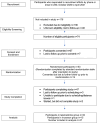Addressing Mental Health Symptoms Among COVID-19 Healthcare Workers: A Heart Rate Variability Biofeedback Pilot Study
- PMID: 39513426
- PMCID: PMC11636445
- DOI: 10.1002/smi.3502
Addressing Mental Health Symptoms Among COVID-19 Healthcare Workers: A Heart Rate Variability Biofeedback Pilot Study
Abstract
Psychological stress among frontline healthcare workers (HCWs) increased during the COVID-19 pandemic, elevating mental health risks. Heart rate variability biofeedback (HRV-BF) is an evidence-based intervention with potential to reduce psychological burden on frontline HCWs; however, no studies have examined its use among this population since the pandemic began. We designed a trial to assess the effects of a brief HRV-BF intervention delivered via telemedicine on measures of anxiety, depression and stress, and heart rate variability, compared to an in-person intervention. We hypothesised that the telemedicine intervention would be non-inferior to the in-person intervention. Using a randomized comparison trial design, we tested a 10-day brief heart rate variability biofeedback intervention among frontline HCWs during the COVID-19 pandemic. They received remote, 30-min guided sessions every other day and were taught methods of heart rate variability biofeedback. Depression, anxiety and stress were assessed at baseline, 10 days, and 40 days with additional measures of anxiety measured before and after each session. HRV scores were collected at baseline, as well as during the course of the 10 days. Multilevel modelling was used to examine the change in depression, anxiety, stress and HRV scores across multiple time points and session types (telemedicine vs. in-person). There was no significant differences between telemedicine (n = 32) and in-person (n = 15) interventions on the main outcomes. Both session types showed a significant decrease in depression, anxiety and stress scores across the entire intervention, and HRV scores significantly increased across both groups. Anxiety levels also significantly decreased after each session. The non-inferiority of the telemedicine intervention to a comparable in-person intervention affirms its promise for decreasing anxiety, depression and stress among frontline HCWs and may offer a cost-effective and feasible tool to use in crises situations.
Keywords: autonomic nervous system; biofeedback; health personnel; psychological; psychology; stress.
© 2024 The Author(s). Stress and Health published by John Wiley & Sons Ltd.
Conflict of interest statement
The authors declare no conflicts of interest.
Figures




References
-
- Albott, C. S. , Wozniak J. R., McGlinch B. P., Wall M. H., Gold B. S., and Vinogradov S.. 2020. “Battle Buddies: Rapid Deployment of a Psychological Resilience Intervention for Health Care Workers During the COVID‐19 Pandemic.” Anesthesia & Analgesia 131, no. 1: 43–54. 10.1213/ane.0000000000004912. - DOI - PMC - PubMed
-
- Appelhans, B. M. , and Luecken L. J.. 2006. “Heart Rate Variability as an Index of Regulated Emotional Responding.” Review of General Psychology 10, no. 3: 229–240. 10.1037/1089-2680.10.3.229. - DOI

